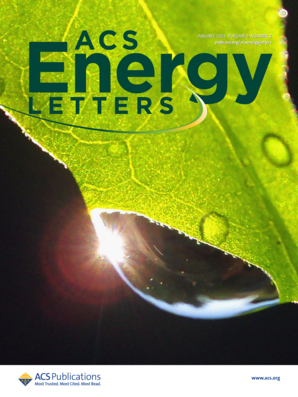Decoupling the Roles of Mobility and Energy Level of Hole-Transport Layers to Efficiency Roll-Off in Perovskite Light-Emitting Diodes
IF 19.3
1区 材料科学
Q1 CHEMISTRY, PHYSICAL
引用次数: 0
Abstract
Metal halide perovskite light-emitting diodes (PeLEDs) have attracted significant attention due to their high efficiency, low cost, and solution processability. While the peak efficiency of PeLEDs has been significantly enhanced, severe efficiency roll-off remains a critical challenge for bright and stable devices. In this study, we investigate the impact of the hole transport layer (HTL) to the efficiency roll-off in PeLED based on FAPbI3. Our findings reveal that the hole mobility of the HTL plays a crucial role in mitigating efficiency roll-off of the device, whereas the energy-level alignment primarily governs the peak efficiency. Furthermore, we implement an HTL with high hole mobility and proper energy-level alignment to promote charge carrier balance, thereby simultaneously realizing peak external quantum efficiency (EQE) enhancement and mitigating efficiency roll-off in FAPbI3-based PeLEDs. Compared with near-infrared devices using the widely adopted low-mobility random copolymer HTL, our devices deliver a peak EQE of 21.7% at 84 mA cm–2, retain over 10% EQE at 1300 mA cm–2, and exhibit nearly 5-fold higher radiance. This study highlights the distinct roles of hole mobility and energy-level alignment in governing efficiency roll-off and peak device efficiency.钙钛矿发光二极管中空穴输运层的迁移率和能级对效率滚降的去耦作用
金属卤化物钙钛矿发光二极管(PeLEDs)因其高效、低成本和溶液可加工性而受到广泛关注。虽然pled的峰值效率已经显著提高,但严重的效率滚降仍然是明亮和稳定器件的关键挑战。在这项研究中,我们研究了空穴传输层(HTL)对基于FAPbI3的PeLED效率滚降的影响。我们的研究结果表明,HTL的空穴迁移率在减轻器件的效率滚降方面起着至关重要的作用,而能级对准主要控制峰值效率。此外,我们实现了一个具有高空穴迁移率和适当的能级对准的HTL,以促进电荷载流子平衡,从而同时实现了fapbi3基pled的峰值外量子效率(EQE)增强和缓解效率滚降。与使用广泛采用的低迁移率无规共聚物HTL的近红外器件相比,我们的器件在84 mA cm-2时提供21.7%的峰值EQE,在1300 mA cm-2时保持超过10%的EQE,并且具有近5倍的高亮度。该研究强调了空穴迁移率和能级对准在控制效率滚转和器件峰值效率方面的独特作用。
本文章由计算机程序翻译,如有差异,请以英文原文为准。
求助全文
约1分钟内获得全文
求助全文
来源期刊

ACS Energy Letters
Energy-Renewable Energy, Sustainability and the Environment
CiteScore
31.20
自引率
5.00%
发文量
469
审稿时长
1 months
期刊介绍:
ACS Energy Letters is a monthly journal that publishes papers reporting new scientific advances in energy research. The journal focuses on topics that are of interest to scientists working in the fundamental and applied sciences. Rapid publication is a central criterion for acceptance, and the journal is known for its quick publication times, with an average of 4-6 weeks from submission to web publication in As Soon As Publishable format.
ACS Energy Letters is ranked as the number one journal in the Web of Science Electrochemistry category. It also ranks within the top 10 journals for Physical Chemistry, Energy & Fuels, and Nanoscience & Nanotechnology.
The journal offers several types of articles, including Letters, Energy Express, Perspectives, Reviews, Editorials, Viewpoints and Energy Focus. Additionally, authors have the option to submit videos that summarize or support the information presented in a Perspective or Review article, which can be highlighted on the journal's website. ACS Energy Letters is abstracted and indexed in Chemical Abstracts Service/SciFinder, EBSCO-summon, PubMed, Web of Science, Scopus and Portico.
 求助内容:
求助内容: 应助结果提醒方式:
应助结果提醒方式:


